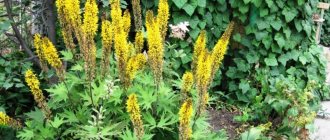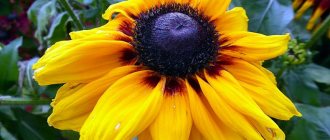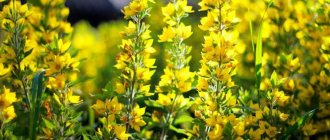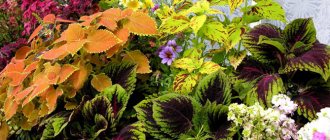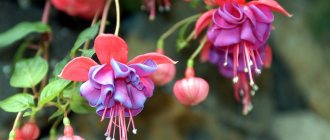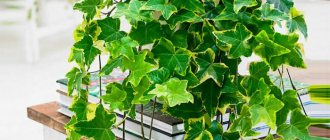Author: Elena N. https://floristics.info/ru/index.php?option=com_contact&view=contact&id=19 Category: Garden plants Published: February 17, 2019Last edits: January 13, 2021
- Growing conditions
- Common loosestrife (Lysimachia vulgaris)
- Medicinal properties
plant (lat. Lysimachia) is a genus of herbaceous perennials, annuals and biennials of the Primrose family. The plant is called loosestrife for the similarity of its leaves to the leaves of willow - this is what all types of willow were called in Rus'. The scientific name of the plant was given in honor of Lysimachus, one of the generals of Alexander the Great, who later became the ruler of Thrace and the king of Macedonia. For a long time it was mistakenly believed that it was he who discovered loosestrife. The genus consists of more than one hundred species. Most loosestrife species grow in the Northern Hemisphere, particularly in North America and East Asia - more than seventy loosestrife species grow in China. Some species grow in South America and South Africa. Loosestrife is found in the Caucasus, the European part of Russia and Central Asia.
Planting and caring for loosestrife
- Planting: sowing seeds in the ground - in June or before winter in September.
- Flowering: from the end of June for 6-7 weeks, sometimes longer.
- Lighting: partial shade or shade, but some species need bright light.
- Soil: fertile and loose, fertilized with rotted manure or compost, with high groundwater levels.
- Watering: only during periods of prolonged lack of rain.
- Fertilizing: not provided, only at the end of autumn the area is fertilized with humus.
- Restriction: this aggressive plant must be limited: dig sheets of slate, plastic or metal around the perimeter of the site.
- Reproduction: seeds, cuttings, root shoots and dividing the bush.
- Pests: aphids.
- Diseases: resistant to all infections.
Read more about growing loosestrife below.
Botanical description
Loosestrife grass is represented by annual, perennial and biennial plants with erect or creeping stems, simple, alternate, entire, whorled or opposite leaves. Loosestrife blooms with white, yellow or pinkish flowers, single axillary or collected in spike-shaped or corymbose panicles. The loosestrife fruit is a spherical or ovoid capsule. Loosestrife is a relative of plants such as cyclamen, milkweed, ambilanthus and primrose.
Loosestrife is an unpretentious plant and, despite its unpretentious appearance, is in demand in gardening: the flowering of loosestrife is distinguished by its abundance and duration. Planting loosestrife and caring for it will not seem labor-intensive to you. This article will describe planting and caring for common loosestrife, since it is the base species of the genus, especially since planting and caring for coin loosestrife or planting and caring for point loosestrife, as well as planting and caring for lily of the valley loosestrife have much in common with growing common loosestrife.
Beneficial features
Due to the medicinal properties of loosestrife, the plant is widely used in both traditional and folk medicine.
Tincture from the loosestrife herb has choleretic, astringent, tonic, wound-healing and antiseptic properties; in traditional medicine it is prescribed for scurvy, jaundice, hemoptysis, convulsions, bleeding and general weakness.
In alternative medicine, herbal infusions are used for rinsing the mouth, for gastrointestinal diseases and thrush, in the form of lotions for the treatment of rheumatism, inflammation of the skin and joints, tumors and severe bruises.
Fresh juice from the plant's herb is used to prevent bruising and as a hemostatic agent. A paste made from fresh leaves is applied to burns and cuts, and is also used for sprained ligaments.
Loosestrife tea is used to clear mucus from the lungs as an expectorant.
Planting loosestrife in open ground
When to plant
Loosestrife can be propagated by seeds and vegetative methods. Sow loosestrife seeds in the ground in June or September, before winter.
- Pyracantha: growing and caring for the garden
Almost all types of loosestrife grow best in shade or partial shade, and coin loosestrife, although it prefers the shade of trees, feels great in the sun. And only purple loosestrife prefers open sunny places.
How to plant
Loosestrife needs fertile, loose and moist areas with close groundwater, and species such as loosestrife, loosestrife, and common loosestrife can simply be planted in a reservoir to a depth of 10 cm. The composition of the soil for loosestrife is not of fundamental importance; it does not like only clay soils. Loosestrife is planted in soil fertilized with well-rotted manure or compost.
Loosestrife is planted like any other plant: the root system is placed in a hole, after which it is covered with soil, the surface of the area is compacted and watered. The distance between loosestrife bushes should be at least half a meter.
Application in landscape design
- Ampelous forms - in hanging baskets and flowerpots.
- Rock gardens and rockeries, the plant goes well with stones.
- Curbs.
- Design of reservoirs, ponds.
- Loosestrife is one of the few plants that allows you to create carpets in the shade.
- Erect loosestrife can be very beautiful in single plantings.
Loosestrife, planting in groups.
Lysimachia Vulgaris in rock garden.
Lysimachia Punctata (spot) variety Yellow Loosestrife in the border near the path.
Loosestrife care
Growing conditions
Planting and caring for loosestrife in open ground does not require much effort. Growing in moist soils, the plant frees you from the need to moisten the soil. The plant will only need to be watered during periods of prolonged absence of rain.
Caring for loosestrife does not involve fertilizing during the growing season, and only at the end of autumn it is necessary to fertilize the soil with humus.
Loosestrife is an invasive plant, especially species such as mottled loosestrife, ciliated loosestrife and racemosa. If you do not dig restrictions in the form of sheets of slate, plastic or metal around the bushes of the plant, it will spread throughout the garden. When the loosestrife has finished blooming, remove the faded inflorescences, and in the fall, trim the stems of erect loosestrife.
Loosestrife flowering
Each type of loosestrife has its own flowering time, and the flowers have their own degree of decorativeness, and we will tell you how and when this or that loosestrife blooms in the section on plant types and varieties.
Transfer
Growing loosestrife involves timely transplantation of the plant. Loosestrife can grow in one place in the garden for up to 10 years, but within two years after planting you will have a developed bush with many children that just need to be planted. Transplantation is carried out in early spring or autumn after leaf fall.
Pests and diseases
Loosestrife is surprisingly resistant to all such problems. The only trouble that can happen to it is an attack by aphids, but in this case you can always purchase the appropriate drug in the store - for example, Biotlin or Antitlin.
Reproduction of loosestrife
As already mentioned, loosestrife propagates by seeds and vegetatively - by dividing the bush, cuttings and root shoots. But experience shows that vegetative methods of propagating loosestrife are more reliable than seed propagation, especially since loosestrife from seeds blooms only 2-3 years after germination. Before sowing at the end of May or beginning of June, loosestrife seeds must be stratified for one and a half to two months in the vegetable drawer of the refrigerator. Before autumn sowing, there is no need to treat the seeds with cold - in the winter soil they will undergo natural stratification, and in the spring you will see friendly shoots.
You can use the seedling seed method: stratified seeds are sown on the surface of a moist substrate consisting of sand and peat, covered with glass and kept at a temperature of 15 ºC in a bright place. In ten to fourteen days, seedlings will appear, and when they get stronger, they are planted in separate containers and, after hardening procedures, planted in open ground in June, keeping an interval of 50 cm between seedlings.
In early spring or autumn, during transplantation, loosestrife can be propagated by dividing the bush. The loosestrife is dug up, the children are separated, then the bush itself is divided into parts so that each section has developed roots and shoots, after which all parts are planted. All these plants will bloom next year. Care for the planted parts as for an adult plant.
Monetary loosestrife is most often propagated by cuttings 10-20 cm long. Cuttings are carried out during autumn pruning or in spring. The cuttings are lowered into water with the lower cut, and after roots form on them, the cuttings are planted in loose, moist soil in a shady area.
- Juniper: cultivation, propagation and types
Types and varieties
We offer you a description of the most famous cultivated species of loosestrife and their best varieties.
Common loosestrife (Lysimachia vulgaris)
A herbaceous perennial, common in nature in meadows, near swamps, along the banks of reservoirs and in the forests of Eurasia and North Africa. It has a creeping rhizome and an erect stem 50 to 100 cm high. The leaves of the common loosestrife are entire, lanceolate, opposite or whorled, smooth above, pubescent below. Yellow bell-shaped flowers with a red-brown spot at the base of the corolla, collected in apical panicles, open in June-August. This type of loosestrife is a honey plant. It is not afraid of waterlogging and can grow directly in water at a depth of 10 cm.
Loosestrife (Lysimachia nemorum)
It grows in Europe near rivers and reservoirs, rising from the foothills to the subalpine zone. It is a perennial up to 30 cm high with large wide leaves and single yellow flowers on long stalks. Flowering of this species begins in May and lasts about two months.
Loosestrife (Lysimachia thyrsiflora)
Or snork grows along the banks of reservoirs and in shallow water. It has a creeping rhizome and straight, strong stems up to 60 cm high. The leaves are narrow, lanceolate, often planted. Small yellow flowers, seemingly fluffy due to protruding stamens, are collected in dense axillary inflorescences up to 3 cm long. Flowering of this species begins in late May or early June.
Loosestrife (Lysimachia punctata)
Grows in the forests of Western and Central Europe. It has a long rhizome, at the end of which there is a whorl of 4-6 underground shoots, pubescent erect stems with sessile broad-lanceolate leaves and lemon-yellow flowers located on the slightly branched tip of the stem. Flowering begins in late June or early July and lasts about a month. This type of loosestrife prefers well-lit places. The best varieties of common loosestrife:
- loosestrife Alexander - a variety with green leaves with a white border along the edge;
- Golden Alexander is a loosestrife with a golden border along the edge of green leaves.
Loosestrife (Lysimachia congestiflora)
Originally from China. This is yellow loosestrife - this is how it looks because of the abundance of golden-yellow flowers with a red stroke at the base of the petals. The foliage of the plant is juicy and dense, bright green. This species became known not so long ago - in 1992. The best varieties of this species:
- Lissy - loosestrife with yellow spherical inflorescences and green leaves;
- Outback Sunset is a variegated variety with a yellow stripe along dark green leaves and yellow flowers;
- Persian carpet - a variety with red veins along dark green leaves of small size and yellow flowers;
- Persian chocolate is a loosestrife with purple foliage that does not die back in the fall and golden-yellow flowers.
Lily of the valley (Lysimachia clethroides)
Or the loosestrife grows in the south of the Primorsky Territory. It has a pinkish-white rhizome, like a lily of the valley, but somewhat thicker, an erect, pubescent and leafy stem up to 20 cm high and small snow-white flowers collected in a dense spike-shaped inflorescence up to 20 cm long. Flowering begins at the end of June and lasts 2-3 weeks. This species has been in culture since the end of the last century. The most famous varieties:
- Lady Jane is a plant with a height of 60 to 90 cm, blooming in late summer;
- Geisha is a variegated variety with a cream border along the edges of the leaves.
Loosestrife (Lysimachia nummularia)
Or coin loosestrife, or meadow loosestrife, or meadow tea - a widespread species in Europe, Japan and North America, growing in floodplain meadows, in shady groves, along the banks of rivers, reservoirs and on the outskirts of swamps. This is a groundcover loosestrife, a perennial with a recumbent stem up to 30 cm long and opposite oval short-petioled leaves up to 2.5 cm long. The flowers of plants of this species are axillary, solitary, yellow, up to 2.5 cm in diameter. The beginning of flowering depends on the light, but on in sunny areas it begins at the end of May or June.
Monarch loosestrife forms a cover not only on horizontal surfaces, but also on steep slopes. One of the most famous varieties of the species is Aurea loosestrife - less winter-hardy than the main species, with yellowish-green leaves.
Purple loosestrife (Lysimachia purpurea)
Or ciliated loosestrife (Lysimachia ciliata), grows naturally in North America. It is an erect perennial up to 45 cm high with paired wide-lanceolate wine-red leaves. The flowers of this species are axillary, apical, small, yellow-lemon, collected in a loose inflorescence. Flowering begins in August. Purple loosestrife prefers open, sunny places.
Black-purple loosestrife (Lysimachia atropurpurea)
Originally from Greece. This is a perennial 45-90 cm high with stunningly beautiful spike-shaped inflorescences, consisting of many flowers of a dark wine, almost black color. The edges of the green leaves are decorated with light corrugation, especially noticeable in young plants. This loosestrife blooms at the end of July. The most famous variety is Beaujolais, with dark purple flowers.
Ephemeral loosestrife (Lysimachia ephemerum)
It grows naturally in Southwestern Europe. This is a frost-resistant perennial up to 90 cm high, which actively grows in width. By the end of summer, flowers appear on the plants, collected in spike-shaped inflorescences. The species has been in culture since the 19th century.
Distribution and ecology
Representatives of the genus are mostly native to the Northern Hemisphere, with significant species diversity observed in East Asia and North America. Some species grow in South Africa and South America.
According to the Great Russian Encyclopedia, 8 species of loosestrife are found in Russia, growing mostly in damp places, including meadows and along the banks of reservoirs [3].
Properties of loosestrife - harm and benefit
Medicinal properties
Common loosestrife has wound-healing, astringent, hemostatic and analgesic effects, but despite this, official medicine is indifferent to loosestrife. But in folk medicine, the plant is used to eliminate diarrhea and internal bleeding, as well as to treat long-term non-healing festering wounds, eczema, stomatitis and thrush.
- What should you add to the soil immediately after picking if you want to get strong seedlings?
Containing saponins, tannins, rutin, carbohydrates, silicic and ascorbic acid, loosestrife is widely used in homeopathy. Fresh leaves of the plant are applied to wounds, abscesses are treated with flowers and leaves, and powder from dried roots relieves pain and heals cuts and burns.
To stop internal bleeding, use loosestrife infusion: pour a tablespoon of dry leaves into a glass of boiling water, infuse, filter and take 1-2 tablespoons three times a day before meals.
After a serious illness, to restore strength, use loosestrife tincture: pour 2 tablespoons of fresh herbs into a glass of vodka, cap tightly, leave in a dark place for 3-4 days, filter and drink 20 drops 3-4 times a day.
This tea helps with headaches and colds: take a tablespoon of chamomile flowers, rosemary leaves and loosestrife herb, steam with two glasses of boiling water, let steep for a few minutes and drink.
Contraindications
Preparations from loosestrife are contraindicated for patients with vascular sclerosis of the extremities, varicose veins, thrombosis, people with high blood pressure and increased blood clotting. Loosestrife is also not used for dry coughs in children.
Economic importance and application
In folk medicine, common loosestrife and coin loosestrife are used for various bleeding and as a wound-healing agent [4].
In Tibetan medicine, the herb Dahurian loosestrife is used [4].
In traditional Chinese medicine, loosestrife is used: Dahurian, bushy-haired and lily of the valley (cletro-shaped).
Loosestrife: diuretic, decongestant and blood flow enhancer; used for enuresis, swelling; in gynecology for leucorrhoea and irregularities (delays) of the menstrual cycle; used externally for hematomas.
Loosestrife: the same pharmaceutical effects are noted, in addition, it has the property of improving digestion. Used for childhood dyspepsia. Research by Chinese specialists in the 70-80s of the 20th century showed the effectiveness of the species in the complex treatment of certain types of tumor processes: breast tumors, thyroid tumors (thyroma), thyrocarcinoma, lymphangitis, lymphosarcomatosis, esophagocarcinoma, gastric cardia cancer (always in combination with other herbal remedies). The people of China often used it for poisonous snake bites.
Unlike the first two species, Dahurian loosestrife is characterized as a vasodilator and sedative, used for hypertension and chronic insomnia [5] [6].
Some types of loosestrife contain tannins and a lot of ascorbic acid. For example, 0.23% (0.73% in dry leaves) of ascorbic acid was found in the leaves of Daurian loosestrife [4].
In homeopathy, the essence of the fresh flowering loosestrife plant is used [4].
Cultivation
Cultivated plant varieties generally require moist soils. Border species have straight stems and white or yellow flowers, the location of which on the stem depends on the species. When planting, add compost or well-rotted manure to the soil. Plants are propagated by dividing bushes in autumn or spring.


